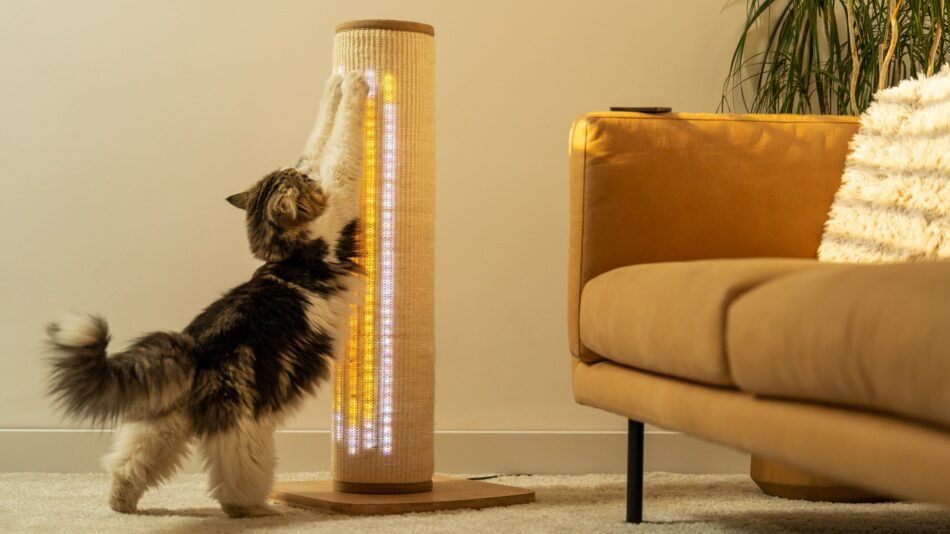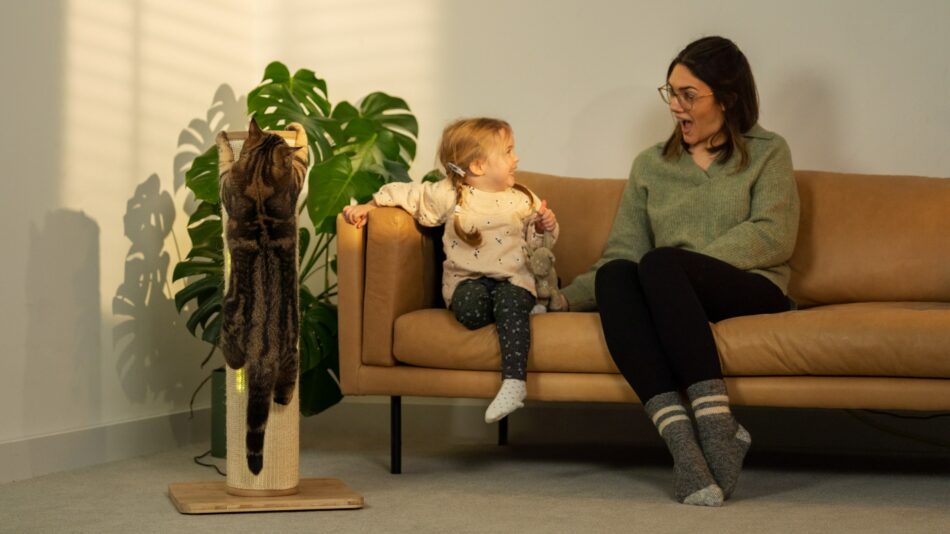How to stop a cat from scratching the couch
Are you tired of finding your beloved couch in shreds, thanks to the work of your favorite feline friend? When it comes to claw-induced destruction of furniture, the struggle can be real for some cat owners. You love your sweet furry friend like family, but you also love your furniture to stay looking nice and new, too. So what are you to do? While asking your cat to stop scratching would be like asking you to stop moving, there are ways you can divert this innate behavior in a more constructive and healthy manner. Keep reading to learn how to stop your cat from scratching the couch and create a harmonious house for everyone.
Why your cat is scratching the couch
When you see your furniture turned into a feline framed art piece, it’s hard not to think this is an act of rebellion. The fact is, scratching is an instinct that’s hardwired into cats and a primal behavior that’s as natural to them as walking upright is to us. That’s why offering an alternative, such as a sturdy cat scratching post, is one of the best ways to encourage this behavior. Let’s take a look at some of the reasons why your cat may be scratching your couch:
Territorial tactics: Cats are natural territorial beings, and scratching is their way of marking their territory. Your couch might just be the chosen canvas for a feline masterpiece, proudly declaring, “This spot is mine!”
Nail maintenance: Scratching isn’t just a decor-destroying hobby for cats; it’s also a crucial part of their nail care routine. They need to shed the outer sheath of their claws, and your couch happens to be the most convenient emery board in town.
Stretching stretches beyond yoga: Cats love a good stretch, and your couch provides the perfect surface for a full-body flex. Consider it their version of a yoga mat – except with a bit more claw action.
Stress relief: Just like we might squeeze a stress ball, cats scratch to release tension. So, if your feline friend is going through a tough time, that couch may be taking one for the team in the name of kitty relaxation.
Visual and scent marking: Scratching isn’t just a physical act for cats; it’s a multi-sensory experience. They leave both visible marks and scent markings from glands in their paws. Your couch is getting a full aromatic treatment.
Attention, please: Cats are clever animals, and they know how to grab your attention. If they’ve noticed that a few claw marks result in a flurry of activity, they might just keep scratching for the thrill of your response.
Boredom buster: Cats need mental and physical stimulation. If they’re not entertained, they might turn to your couch for some recreational scratching. Consider it their way of saying, “I need more toys, please”.
Texture preference: Cats have preferences too. Your couch might offer a texture that’s particularly appealing to your feline friend. It’s like their way of telling you they have a sophisticated taste in furniture.
Types of couches cats are prone to scratch
While some couch materials are more likely to be destroyed by a curious kitty than others, there are a few couches that you will want to steer clear of if you have a cat. These materials offer enough satisfying resistance for cats to sink their claws into with comfort and ease, making your couch a shredded place to sit.
Tweed couches may offer a lot in their beautiful texture and ease of cleaning, but for a cat, it’s a welcoming committee for their claws. The tightly woven, looped texture of tweed is a perfect hook for your cat’s claws to get into and begin to rip out the fabric one thread at a time. Not to mention, trying to get cat hair off tweed is a nightmare as well, so best to avoid this type of couch altogether if you’re in a feline-friendly home.
The second type of couch to avoid if you don’t want it shredded is chenille. While the rich texture of this fabric may look pretty, it’s actually created of small, nubby piles to give it that raised look and feel. And those small, nubby piles are perfect for cat claws to sink right into and rip out. Unfortunately, with chenille, once those loops are ruined, they can’t be repaired, so it’s best to avoid chenille couches if you can.
Lastly on the list of couches cats are prone to scratch is the luxurious velvet. Simply stated – cats and velvet don’t mix. This material is extremely delicate and not a match for the sharp kneeds and paws of cat claws. But if you’re a cat owner and absolutely love the royal look of velvet, all is not lost. Microfiber and microsuede couches provide similar look and feel options with a more cat-claw-resistant fabric.
A step-by-step guide to stop your cat from scratching the couch
If your couch is bearing the brunt of your cat’s relentless scratching, a harmonious coexistence between your feline friend and your furniture can be within reach. Follow this simple, yet effective, step-by-step guide to put an end to the couch catastrophe:
- Provide alternatives: Cats scratch to mark territory and sharpen their claws. Offer enticing alternatives like scratching posts made of materials cats love, such as sisal or cardboard.
- Placement matters: Strategically place the scratching posts near the couch. If your cat loves to scratch a particular spot on the couch, put the scratching post right there.
- Catnip attraction: Sprinkle a bit of catnip on the scratching post to make it more appealing. The allure of this feline favorite can redirect your cat’s attention away from the couch quickly.
- Trim those claws: Regular nail trims can minimize the impact of scratching. Invest in cat-friendly nail clippers and make it a bonding experience.
- Protect with covers: Use furniture covers, such as snuggly warm cat blankets or a cozy cat donut bed, to shield the couch temporarily. Cats might find these less satisfying to scratch.
- Positive reinforcement: Reward your cat when they use the scratching post. Positive reinforcement can strengthen the association between desired behavior and rewards.
By training your cat to use a scratching post instead, you’ll be well on your way to a scratch-free sofa and a happier feline companion. Remember, a little patience and creativity go a long way in fostering a harmonious home environment for both you and your beloved cat.
Training positive scratching with cat scratch posts
Transform your cat’s destructive scratching tendencies into a positive and entertaining experience with the magic of cat scratching posts. Here are some ways you can make a scratching post your feline’s new best friend:
Scratch-worthy selection: Cats have preferences, and so do scratch posts. Experiment with various materials like sisal or cardboard to discover your cat’s scratching paradise. The Omlet Stak Scratching Post is a durable and sustainable option as the refillable cardboard layers can easily be removed, recycled, and replaced when worn down, allowing for continued scratching fun.
Likewise, the Omlet Switch Scratching Post is wrapped in the feline favorite, sisal, and was created with an innovative built-in light show that interactively keeps your cat entertained and engaged for hours.
Positive praise: One of the best ways to encourage scratching on a post is to shower your cat with praise and treats every time they use the post. Positive reinforcement creates a connection between desired behavior and rewards and makes your cat want to come back again and again. Avoid negative reactions if your cat scratches elsewhere – instead, gently redirect them back to the scratching post and reward them when they comply.
Playful engagement: Make the scratch post a play zone. Hang cat toys or dangle enticing strings nearby to turn scratching into a playful activity that you and your cat can enjoy together. Or just get your cat the Omlet Switch Scratcher which doesn’t need any extras added as the 1200+ interactive light modes are entertaining enough.
Couch materials your cat won’t scratch
If it’s time to upgrade your couch to a feline-friendly haven, choosing materials that defy the irresistible allure of your cat’s claws is essential. We recommend three main fabrics for scratch-resistant comfort: microfiber, faux suede, and synthetic polyester. Microfiber is made with smooth, tightly woven fibers, and serves as a fortress against claw incursions, deterring even the most determined scratchers. Similarly, faux suede offers a soft and smooth texture that beckons your cat to snuggle for a snooze instead of starting a scratch session. Lastly, synthetic polyester is a resilient material that withstands the test of time and tenacious paws.
These materials not only provide a cozy spot for your cat to lounge but also serve as a stylish sanctuary that stands up to the whims of your furry companion. So if you are searching for a way to create comfort and style for you and your cat, try one of these couch materials instead.
More furniture your feline may scratch
While the couch often bears the brunt of scratching escapades, your cat’s artistic impulses might extend to other unsuspecting pieces of furniture. From the armchair in the corner, to the enticing wooden coffee table, to the luxurious drapes hanging by the window – no spot is entirely immune. Even the carpet and walls aren’t safe from a spontaneous scratching session.
In order to safeguard your home’s decor, consider incorporating cat scratching posts strategically near any and all of these tempting targets. By doing so, you provide your cat with an alternative outlet for their natural instincts, sparing your furniture from the unintended consequences of their claws. With the right cat scratching posts, you can turn your home into a haven where both style and scratching habits can peacefully coexist.
The feline breeds most likely to scratch
While scratching is an innate behavior found in all cat breeds, some cats stand out as “most likely to scratch” more than others. But do keep in mind that individual personalities vary among breeds, so every cat is different in their propensity to scratch. Meet the playful perpetrators:
Siamese, with their curious nature and penchant for climbing, might extend their claws in exploration more so than their feline counterparts.
The Maine coon, known for their size and agility, could inadvertently leave their mark on furniture during an adventurous stretch.
Bengal cats, with their wild ancestry, may unleash their inner jungle instincts through enthusiastic scratching.
While the Sphynx, though hairless, possesses a desire for tactile stimulation and may express it through scratching.
Caring for your cats with Omlet
Omlet’s commitment to innovation extends beyond products; it’s a promise to bring pets and people closer together. Our designs aren’t just creations; they’re bridges connecting you and your cats in the most delightful ways. Whether it’s the playfulness of interactive and engaging cat scratching posts or taking the adventure outdoors with our Catio or blending style and functionality seamlessly with our furniture litter box, Omlet is your companion in crafting a world where the joy of pet ownership knows no bounds. Embrace the extraordinary with Omlet – because your cats deserve nothing less.
This entry was posted in Cats


